ANSAN/SEOUL – Two years have passed since the Sewol ferry sank off South Korea’s southwest coast on April 16, but Kim Jeong-hee (not her real name) still cannot let go of her youngest son Jeon Chan-ho who drowned in the cold sea at the age of 18.
“Before Chan-ho left home for the school trip to Jejudo Isalnd, he kissed me on my cheek asking me not to worry,” Kim told The Korea Herald outside the joint altar set up in Ansan, Gyeonggi Province.
“My son usually texts or rings me a lot, but strangely, I heard nothing from him that day. I just thought that he would be busy having fun with his friends,” Kim said, wiping tears from her cheek.
“I should have called him to hear his voice one last time. … That’s what I regret every day.”
“Before Chan-ho left home for the school trip to Jejudo Isalnd, he kissed me on my cheek asking me not to worry,” Kim told The Korea Herald outside the joint altar set up in Ansan, Gyeonggi Province.
“My son usually texts or rings me a lot, but strangely, I heard nothing from him that day. I just thought that he would be busy having fun with his friends,” Kim said, wiping tears from her cheek.
“I should have called him to hear his voice one last time. … That’s what I regret every day.”
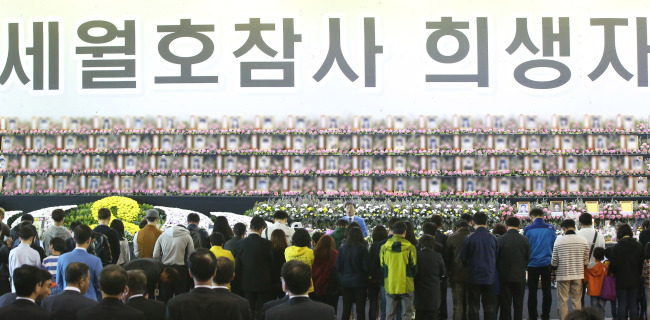
The April is once again marked with apologies and promises not to forget the 304 people who died in the Sewol ferry tragedy. Most of them were students from Danwon High School in Ansan on a school trip to Jejudo Island.
The captain and crewmembers were the first to flee the sinking ferry without giving an evacuation order, while other passengers onboard were asked to “stand still.” Only 172 were rescued, with nine people remaining missing in the sea.
Over the past two years, however, little has been found out about what exactly caused the man-made disaster and why the government failed to save more lives. Only the ferry’s captain, CEO of the shipping operator and a maritime police officer on the rescue ship were punished.
An overloaded cargo, illegal redesign of the ferry and a cozy relationship between ship operators and state regulators are loosely thought to be the causes. But unsolved questions remain, leading the victims’ families to demand “truth” in the deadly accident.
“What would take so long to find out the truth about the accident and punish those responsible? Why is there so much to cover up?” the mother of Chan-ho lamented, lashing out at the government’s lukewarm efforts to investigate the accident.
“I don’t need any financial compensation (offered by the government). All I need is the truth about why my son had to die.”
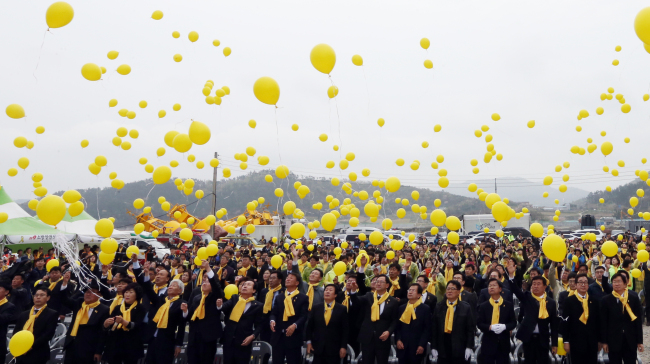
To mark the second anniversary of the ferry sinking, scores of memorial events took place across the nation on Saturday, standing in solidarity with the victims’ bereaved families.
In Jindo Island near the site of the accident, some 2,500 mourners gathered to support families of the nine victims that remain unaccounted for. Oceans Minister Kim Young-Suk promised to do his best to bring back the missing bodies to the families. The government has commissioned a Chinese firm to raise the ferry, which is 37 meters below the surface, by July.
In Ansan, about 2,500 people, including the victims’ grieving families and lawmakers, gathered in the morning for a memorial event near the joint altar. They watched performances by choirs and documentaries in which the bereaved families recalled their loved ones.
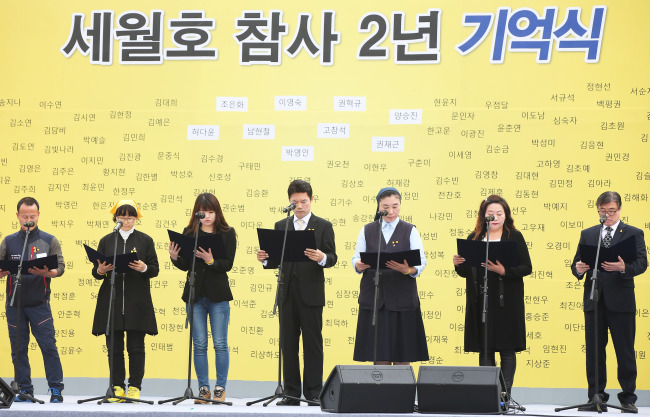
Government officials, including Education Minister Lee Joon-sik and Gyeonggi Province Governor, took to the stage and again pledged utmost efforts to find out the causes of the accident and salvage the ferry.
Some 13,000 mourners, many of whom had tied yellow ribbons to their bags and cloths, flocked to the altar to lay flowers in front of the victims’ portraits in school uniforms.
“These children would have entered university this year if they had not died in the sea,” said Lee Young-min, 40, with tears welling in her eyes, outside the altar. “Every single child is precious and deserves to live. I am sorry that we, adults, could not save them.”
“I hope that the accident not only stays in our hearts but also fixes the country to make it more livable, safer.”
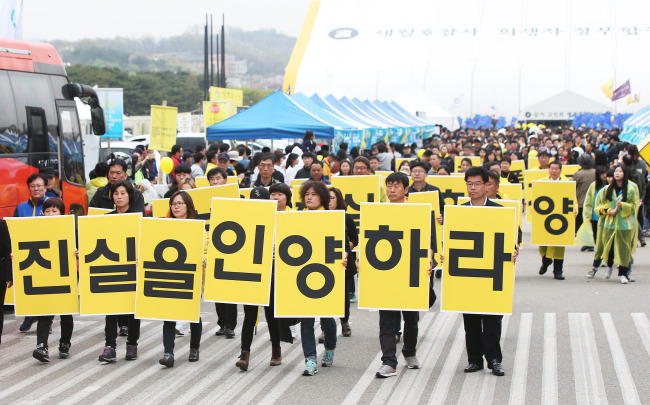
Yoo Ja-young, an 18-year-old student, said that the Sewol ferry sinking changed her live forever. “Many people went to heaven due to the accident, but we still don’t know why. That made me participate more in social movement because I now know that this country cannot protect me.”

Some five minutes away by car from the altar, hundreds of mourners visited “Memory Classrooms,” which have remained intact in honor of student victims, in Danwon High School. The visitors left flowers, gifts, snacks and letters on the desks, wishing the victims better lives in heaven.
In the teachers’ room on the second floor, two former students of the deceased teacher Lee Ji-hye remembered their teacher by leaving a message on the guestbook and taking pictures together on Lee’s chair.
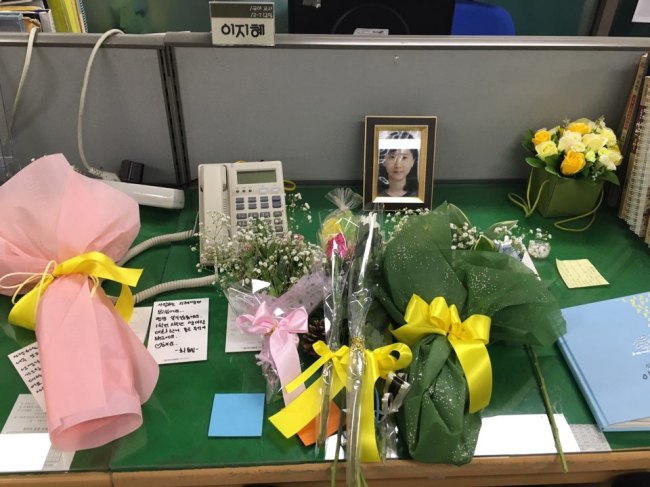
“I could not believe that my teacher was on the sinking ferry, but I started to feel that it was real as she never picked up my call,” Byun Jin-kyung, 24, said. “She was tough outside, but very warm inside. I still remember that she was so happy to see me enter a university.”
While groups of friends and families continued to browse the classrooms, a 40-something man, who wanted to be identified only by his surname Song, cracked a smile while revisiting memories he had with his former student Lee Hye-kyung.
“Hye-kyung’s dream was to become a makeup artist. She was a very cute and popular girl around the town,” he said, pointing to letters piled up on her desk. “This classroom is where Hye-kyung’s friends come to share their memories and stories.”
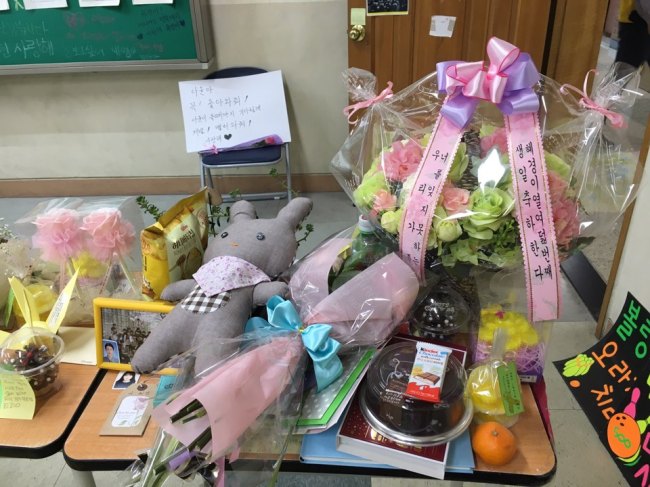
One of the letters left in November 2014 by Lee’s closest friend read: “How are you? I hope it is not so cold up there. It is already winter here. You know what? I cut my hair today. Please see me and let me know how it is. I think I look okay. Have a very good weekend. I will see you very soon. Always love you.”
Song said that he was afraid of having the classroom removed. “Nothing has been solved for the past years. No one took responsibility. How can be the government so irresponsible and incompetent? Why does it keep trying to remove all the traces of the kids?”
The “Memory Classrooms” have been a source of contention between education ministry and victims’ families. School officials cited shortage of classrooms and a negative impact on attending students, but families demanded preservation of the shrine so as not to forget the tragedy.
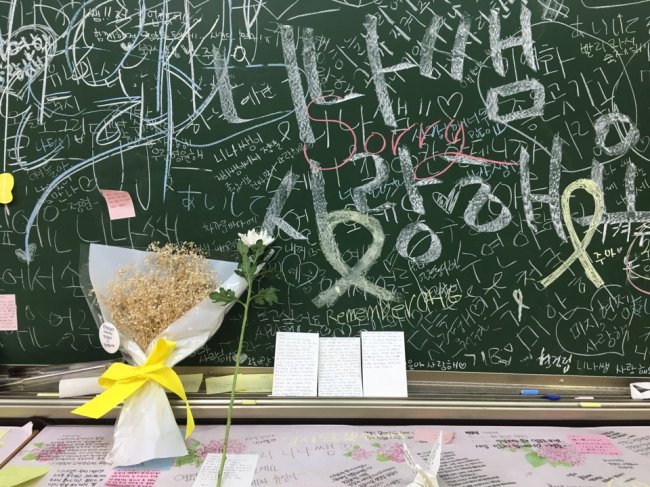
Rain started to pour in the afternoon, but it did not stop Koreans from gathering in Gwanghwamun Square in central Seoul for the day’s biggest and last memorial event.
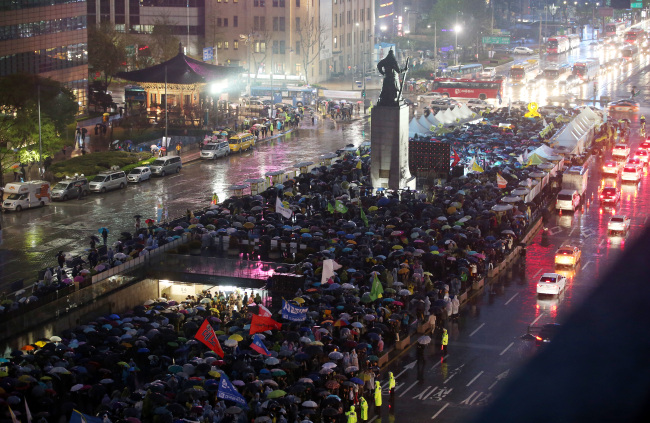
At dusk, an estimated 12,000 people packed into the square to join the event, with hundreds of people waiting in a 1 kilometer-long queue to pay tribute to the victims at the joint altar.
“I came here because I felt guilty not coming here last year,” said Park Eun-ah, a 30-year-old office worker. “Frankly, I never thought that the cause of the ferry sinking would not be found by now.”
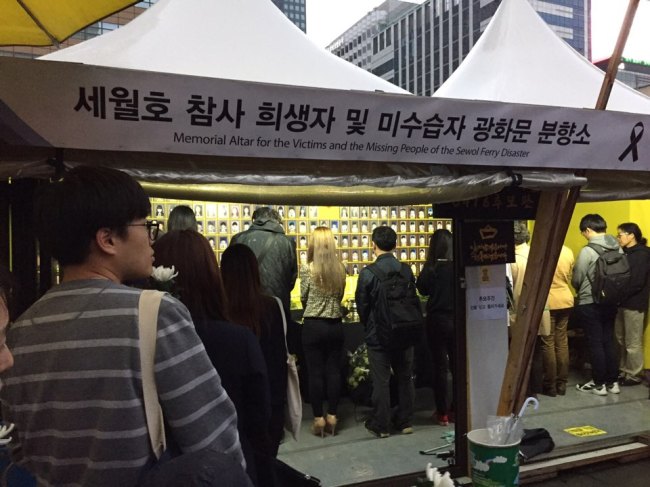
“I might have intentionally avoided the bereaved families and their supporters because it was too much painful,” she said, stepping out of the memorial altar established in Gwanghwamun Square. “But this is not the issue that I can just put aside just because I feel uncomfortable.”
During the two-hour event, participants and hundreds of civic groups called for a more thorough investigation into the deadly accident, a revision to the Sewol Special Act and the prompt lifting of the ferry Sewol.
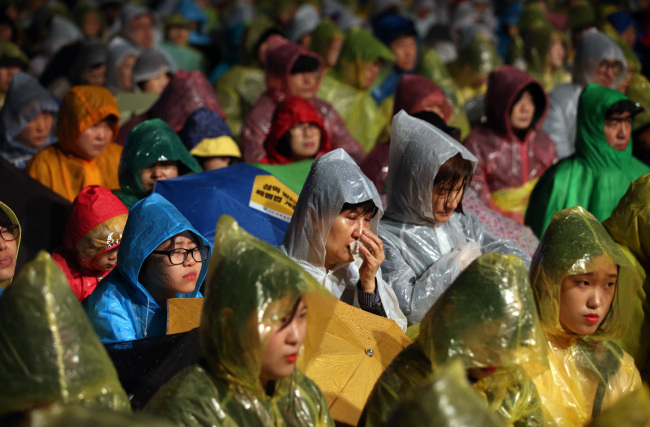
They chanted “We will not forget” and “We will stand together with you” while sitting down on the cold and wet concrete floor in raincoats. Memorial songs were sung, poems were read and videos were played.
Rep. Park Joo-min of the Minjoo Party of Korea, who has previously represented the victims’ families, took to the podium to vow his efforts to bring justice for the Sewol tragedy in the National Assembly.
“Corrupt investigators, incompetent government and social ill in this society resulted in the disaster. This is not a special event that happens to special people. This is an event that can happen to any one of us as long as the problems are not fixed,” Park said.
“I will amend the Special Sewol Act and help launch an independent probe into the case by prosecutors.”
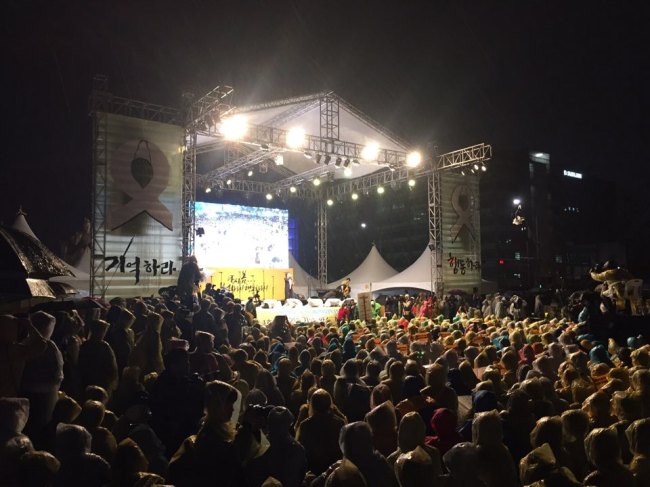
Yoo kyung-geun, father of the deceased Ye-eun, asked the participants whether they were ready to get through the upcoming difficulties to fight for “truth.” The crowds shouted “Yes” in response.
“Some 120 lawmakers entered the 20th National Assembly, promising to allow the special investigation into the Sewol ferry tragedy to continue,” Yoo said. “Please encourage and pressure lawmakers in your region to keep their promises.”
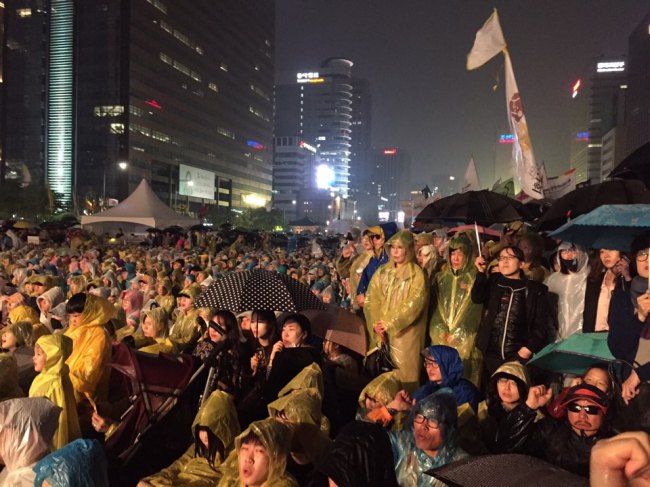
The memorial event came to an end at around 9:30 with 10 citizens from Yongin pulling off a flash-mob performance to a song that had been heard all across the country that day.
Part of the lyrics of the song said: “Darkness cannot beat light, lies cannot win truth, truth does not capsize, and we won’t give up.”
By Ock Hyun-ju (laeticia.ock@heraldcorp.com)
-
Articles by Korea Herald








![[Hello India] Hyundai Motor vows to boost 'clean mobility' in India](http://res.heraldm.com/phpwas/restmb_idxmake.php?idx=644&simg=/content/image/2024/04/25/20240425050672_0.jpg&u=)











